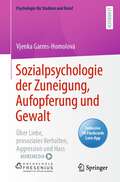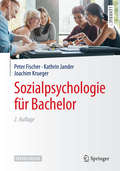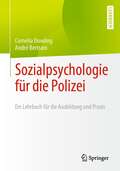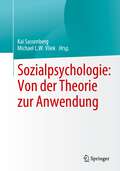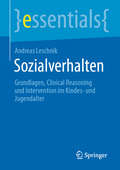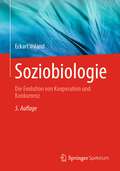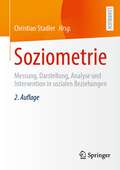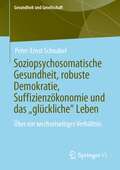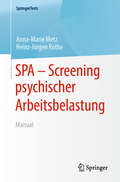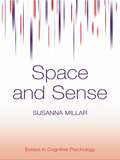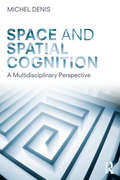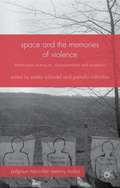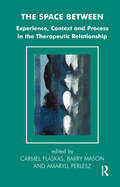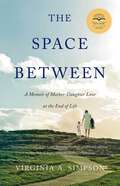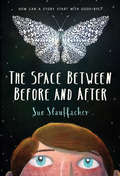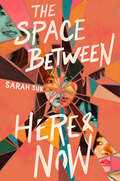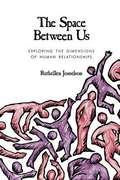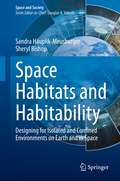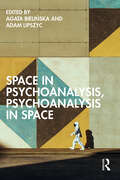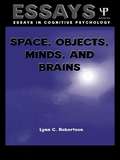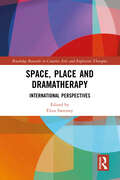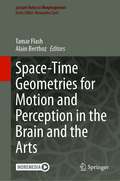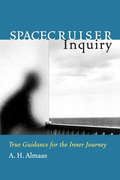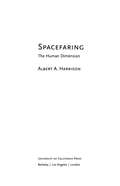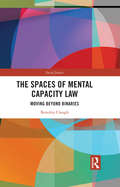- Table View
- List View
Sozialpsychologie der Zuneigung, Aufopferung und Gewalt: Über Liebe, prosoziales Verhalten, Aggression und Hass (Psychologie für Studium und Beruf)
by Vjenka Garms-HomolováDieses Lehrbuch der Sozialpsychologie erklärt alltagsnah und kompakt die ganze Bandbreite zwischenmenschlicher Beziehungen: Warum finden Menschen einander attraktiv und gehen Beziehungen ein? Warum helfen Menschen oder opfern sich gar für andere auf? Wie entstehen Aggressionen oder gar Hass? Diese Themen der Sozialpsychologie sind brandaktuell, wie die Diskussionen um Aggression im Internet und Hassphänomene zeigen.
Sozialpsychologie für Bachelor (Springer-Lehrbuch)
by Peter Fischer Kathrin Jander Joachim KruegerIn dem Buch sind die prüfungsrelevanten Themen des Grundlagenfachs Sozialpsychologie, inklusive aktueller Trends wie positive Psychologie und soziale Neurowissenschaften, lerngerecht aufbereitet: mit Fallbeispielen, Definitionen, Studienboxen, Exkursen und Kontrollfragen. Auf der begleitenden Website stehen mp3-Hörbeiträge, Lerntools und Vorlesungsmaterialien für Dozenten zum Download bereit. Für Studierende im Bachelorstudium und alle, die einen leicht verständlichen Einstieg in die Sozialpsychologie suchen.
Sozialpsychologie für die Polizei: Ein Lehrbuch für die Ausbildung und Praxis
by Cornelia Dowling André BertramDieses Lehrbuch bietet einen verständlichen Überblick über die Themen der Sozialpsychologie für die Ausbildung und Berufspraxis der Polizei. Insbesondere kann es zu Rate gezogen werden, wenn es im Polizeialltag darum geht, schnell und unter Unsicherheit Personen und Situationen zu beurteilen, angemessen auf Provokationen zu reagieren, effizient in Gruppen und Teams zusammenzuarbeiten, bei Fremdgruppen gefährliche Gruppenprozesse vorherzusehen und kompetent beim Umgang mit Konflikten zu sein. Umfangreiche Forschungsergebnisse der Sozialpsychologie zu all diesen Herausforderungen werden im Buch mit Sachverhalten aus dem Polizeialltag illustriert und so verständlich gemacht.
Sozialpsychologie: Von der Theorie zur Anwendung
by Kai Sassenberg Michael L. W. VliekDieses aktuelle und anwendungsorientierte Lehrbuch bringt führende Wissenschaftler zusammen, um zu veranschaulichen, wie wichtige Theorien und Konzepte der Sozialpsychologie helfen, Verhalten vorherzusagen und zu erklären, und wie sie erfolgreich auf soziale und praktische Probleme angewendet werden können. Es konzentriert sich auf robuste Theorien und Modelle, die für ihre erfolgreiche Anwendung bekannt sind, und deckt ein breites Spektrum von Bereichen ab - von Interventionen im Klassenzimmer über Gesundheitsverhalten und finanzielle Entscheidungsfindung bis hin zum Klimawandel und vieles mehr. Jedes Kapitel besteht aus einem theoretischen Teil, in dem die Schlüsselkonzepte definiert und die Theorie zusammengefasst werden, sowie aus einem Anwendungsteil, der die Forschung in einem angewandten Kontext zusammenfasst und Details zu einer bestimmten Studie einschließlich des jeweiligen Anwendungsumfelds liefert. Das Lehrbuch zeigt fachkundig, wie die Theorie sinnvolle Vorhersagen für reale Kontexte machen kann, und scheut sich nicht, die potenziellen Hürden und Fallstricke bei der Anwendung einer Theorie und der ihr zugrunde liegenden Konzepte in einem bestimmten Kontext zu erläutern. Entscheidend ist, dass dieses Format auf die Überprüfung der Theorie in angewandten Kontexten abzielt und eine genauere Untersuchung der Gründe und Umstände ermöglicht, warum und unter welchen Umständen Interventionen erfolgreich sein können, um einen gewünschten Verhaltens- oder psychologischen Endzustand zu erreichen. Zu den untersuchten Themen gehören: Mindset-Theorie der Handlungsphasen und Wenn-dann-Planung Qualität der Motivation in der Selbstbestimmungstheorie Die Fokustheorie des normativen Verhaltens Theorie der sozialen Identität und Theorie des Kontakts zwischen Gruppen Gruppenübergreifende Vergebung Social Psychology in Action ist ein wichtiges Hilfsmittel für fortgeschrittene Studenten der Sozial- und Kulturpsychologie sowie für Studenten der Verhaltensökonomie, die ein tieferes Verständnis der wichtigsten Theorien und Anwendungen dieser Bereiche entwickeln möchten. Praktiker, die in den Bereichen Organisationsverhalten und -management, Gesundheitskommunikation, Sozialarbeit sowie Erziehungswissenschaft und Pädagogik tätig sind, werden das Buch ebenfalls als relevant für ihre Arbeit empfinden.
Sozialverhalten: Grundlagen, Clinical Reasoning und Intervention im Kindes- und Jugendalter (essentials)
by Andreas LeschnikIn diesem essential werden die Grundlagen des Sozialverhaltens erklärt. Außerdem gibt es einen kurzen Überblick über die kindliche Entwicklung des Sozialverhaltens. Im weiteren Verlauf wird das hypothetisch-deduktive Clinical Reasoning zum Erstellen einer therapeutischen Diagnose bei Kindern und Jugendlichen mit Störungen des Sozialverhaltens eingesetzt. Am Ende bietet dieses essential Interventionsmöglichkeiten für Kinder und Jugendliche mit Störungen des sozialen Verhaltens.
Soziobiologie: Die Evolution von Kooperation und Konkurrenz
by Eckart VolandSoziobiologie ist den evolutionsbiologischen Ursprüngen und Gründen tierlichen und menschlichen Sozialverhaltens auf der Spur. In diesem Buch werden Strategien sozialer Konkurrenz, also Gewalt, Kampf und Dominanz behandelt, aber auch Kooperation, Altruismus und Solidarität. Die Interessen der beiden Geschlechtern sind Treibstoff der sexuellen Selektion. Kooperation ist also immer auch brüchiger Kompromiss im Kampf der Geschlechter zu verstehen. Außerdem geht es um die neuesten Erkenntnisse zur Evolution der Eltern/Kind-Verhältnisses und um ein Brutpflegeverhalten, das Kindesvernachlässigung und zugleich auch tief empfundene elterliche Zuneigung und Fürsorge möglich macht. Beschrieben wird, wie eine evolutionäre Perspektive auf das menschliche Verhalten zum modernen Menschenbild beiträgt. Das Buch richtet sich an Studierende und Lehrende der Biologie, Anthropologie, Psychologie und Sozialwissenschaften und an alle an der evolutionären Geschichte des menschlichen Sozialverhaltens Interessierte.
Soziometrie: Messung, Darstellung, Analyse und Intervention in sozialen Beziehungen
by Christian StadlerSoziometrie ist eine sowohl qualitative wie quantitative Herangehensweise, um Beziehungen in Gruppen zu untersuchen. Sie untersucht das Wahlverhalten von Menschen anhand bestimmter Kriterien und dient gleichzeitig als Intervention für eine Verbesserung von Gruppenzusammenhalt und -leistung. Dieses Buch bietet eine kompakte Einführung in die Grundlagen der Soziometrie. Es werden unter anderem das sozionomischen System, verwandte Untersuchungsmethoden und Weiterentwicklungen (z.B. der populären Netzwerkananalyse) sowie zahlreiche Instrumente und psychodramatische Messverfahren dargestellt. Darüber hinaus werden in einem Praxisteil zahlreiche Fallbeispiele aus unterschiedlichen Anwendungsfeldern erörtert.
Soziopsychosomatische Gesundheit, robuste Demokratie, Suffizienzökonomie und das „glückliche“ Leben: Über ein wechselseitiges Verhältnis (Gesundheit und Gesellschaft)
by Peter-Ernst SchnabelNicht einmal zehn Prozent der knapp zweihundertdreißig Milliarden Euro, die sich die Deutschen ihre Krankenversorgung jährlich kosten lassen, fließen gegenwärtig in die Präventionspolitik und davon wiederum nicht mehr als zwanzig Prozent in die Förderung der Gesundheit. Die vorliegende Untersuchung setzt sich in kritisch-konstruktiver Manier mit den interventionsphilosophischen, systemischen und professionspolitischen Hindernissen auseinander, die der längst fälligen Beseitigung dieses Unterversorgungsdilemmas im Wege stehen. Sie bemüht sich, mit dem Irrglauben aufzuräumen, dass eine Gesundheitsförderungspolitik, die mehr sein will, als die bloße Verhinderung von Krankheit und Gebrechen, realisiert werden könne, ohne die bestehenden politischen, wirtschaftlichen und gesellschaftlichen Bedingungen grundlegend zu verändern. Und sie macht Vorschläge, in welche Richtung diese Veränderung gehen könnte.
SPA - Screening psychischer Arbeitsbelastung: Manual (SpringerTests)
by Anna-Marie Metz Heinz-Jürgen RotheArbeitsbedingte psychische Erkrankungen sind in den letzten 10 Jahren zu den häufigsten Ursachen für Fehlzeiten und Erwerbsminderungsrenten geworden. Im Mittelpunkt des Buches stehen die detaillierte Beschreibung eines psychologischen Verfahrens zur qualitätsgesicherten, effizienten und praktikablen Analyse und Beurteilung psychischer Belastungsfaktoren in Arbeitsprozessen. Aus den Ergebnissen werden Hinweise für bedingungs- und personenbezogene gesundheitsförderliche Maßnahmen abgeleitet. Das Instrument hat sich bei Gefährdungsbeurteilungen in Unternehmen aller Größen und Branchen bewährt, es ermöglicht, Schwachstellen in der Gestaltung von Arbeitssituationen zu identifizieren sowie komplexe Beziehungen zwischen Arbeitsinhalt, Arbeitsbedingungen und deren Folgen wissenschaftlich aufzuklären.
Space and Sense (Essays in Cognitive Psychology)
by Susanna MillarHow do we perceive the space around us, locate objects within it, and make our way through it? What do the senses contribute? This book focuses on touch in order to examine which aspects of vision and touch overlap in spatial processing. It argues that spatial processing depends crucially on integrating diverse sensory inputs as reference cues for the location, distance or direction response that spatial tasks demand. Space and Sense shows how perception by touch, as by vision, can be helped by external reference cues, and that ‘visual’ illusions that are also found in touch depend on common factors and do not occur by chance. Susanna Millar presents new evidence on the role of spatial cues in touch and movement both with and without vision, and discusses the interaction of both touch and movement with vision in spatial tasks. The book shows how perception by touch, as by vision, can be helped by external reference cues, and that ‘visual’ illusions that are also found in touch depend on common factors and do not occur by chance. It challenges traditional views of explicit external reference cues, showing that they can improve spatial recall with inputs from touch and movement, contrary to the held belief. Space and Sense provides empirical evidence for an important distinction between spatial vision and vision that excludes spatial cues in relation to touch. This important new volume extends previous descriptions of bimodal effects in vision and space.
Space and Spatial Cognition: A Multidisciplinary Perspective
by Michel DenisAll living creatures inscribe their activity in space. Human beings acquire knowledge of this space by traversing it, listening to verbal descriptions, and looking at maps, atlases, and digital media. We memorize routes, compare distances mentally, and retrieve our starting place after a long journey. Space and Spatial Cognition provides an up-to-date introduction to the elements of human navigation and the mental representation of our environment. This book explores the mental capacities which enable us to create shortcuts, imagine new pathways, and thus demonstrate our adaptation to the environment. Using a multidisciplinary approach which draws on psychology, neuroscience, geography, architecture and the visual arts, the author presents answers to a number of questions. Which mental capacities do people mobilize when confronted with space? Which brain functions do they implement? How do digital technologies extend these capacities? By presenting space at the crossroads of a number of disciplines, this volume reveals how each of them enhances our understanding of human behaviour in space. Space and Spatial Cognition provides a unique insight into all facets of spatial cognition, including spatial behaviour, language, and future technologies. It will be the ideal companion for all students and researchers in the field.
Space and the Memories of Violence
by Estela Schindel Pamela ColomboAuthors from a variety of disciplines dealing with diverse historical cases engage with the spatial deployment of violence and the possibilities for memory and resistance in contexts of state sponsored violence, enforced disappearances and regimes of exception. Contributors include Aleida Assmann, Jay Winter and David Harvey.
The Space Between: Experience, Context, and Process in the Therapeutic Relationship (The Systemic Thinking and Practice Series)
by David Campbell Ros Draper Carmel Flaskas Barry Mason Amaryll Perlesz John Byng-HallThe papers in this book focus on many different aspects of the therapeutic relationship, including the self of the therapist, working cross-culturally and with language difference, impasse, risk taking, the place of research, and the influence of theory. Clinical examples illustrate successful as well as less succssful outcomes in therapy, and these clinical explorations make the book accessible to both systemic and non-systemic practitioners alike. Part of the Systemic Thinking and Practice Series.Contributors:Rhonda Brown; John Burnham; John Byng-Hall; Alan Carr; Carmel Flaskas; Jo Howard; Alfred Hurst; Ellie Kavner; Sebastian Kraemer; Inga-Britt Krause; Rabia Malik; Maeve Malley; Michael Maltby; Barry Mason; Sue McNab; Amaryll Perlesz; David Pocock; Hitesh Raval; Justin Schlicht; and Lennox K. Thomas.
The Space Between: A Memoir of Mother-Daughter Love at the End of Life
by Virginia A. Simpson2015-2016 Sarton Story Circle: Memoir Winner 2016-2017 Readers Views Award: Memoir/Autobiography/Biography Winner, West Pacific Regional Winner 2017 Independent Press Award: Relationships Winner 2017 Northern California Publishers and Authors Second Place in Book Cover 2017 Northern California Publishers and Authors Second Place in Memoir 2017 Readers' Favorite Book Award Bronze Winner 2017 International Book Awards: Autobiography/Memoir Finalist 2016 National Indie Excellence Awards: Memoir Finalist Everyone has or had a mother. Dr. Virginia A. Simpson did too. She thought they had a wonderful relationship and had worked out all of their issues when a life-threatening illness necessitated her mother, Ruth, come live with her. When her mother moved in, she brought with her all their old issues and during the six years they lived together, they added more. Although an expert in the field of death, dying, and bereavement, Virginia often found herself overwhelmed by her caregiving role as her mother&’s health continued to decline. She also felt herself on a race against time to heal their relationship before her mother died. Described as &“stunning, beautiful, and honest,&” The Space Between: A Memoir of Mother-Daughter Love at the End of Life offers an intimate window into the challenges of being a caregiving while also providing important information about the realities of end of life care. The Space Between gives us hope that even the most contentious relationship can be healed. By the end of Ruth&’s life, the only space between Virginia and her mother was filled with love.
The Space Between Before and After
by Sue StauffacherThomas learns to navigate his grief when his mother disappears by creating a fantasy story about his mother where she is safe.One morning 10-year-old Thomas's mother tells him about a dream she had about taking a trip by herself--which is odd because lately his mother has been too depressed to even leave the house. But when Thomas gets home from school, she's gone. The police search everywhere, and although they find her car, they can't find her. Thomas's neighbor helps him cope with his anxiety by having him think up a fantasy about where she might have gone. As time passes, Thomas takes charge of the story sending his mother on a quest in the astral plane. With the help of this narrative journey, his family, and his friends, Thomas begins to realize that even if his mother never comes back, he can still hold a place for her in his heart and mind.
The Space between Here & Now
by Sarah SukPerfect for fans of They Both Die at the End and You’ve Reached Sam, this gripping, atmospheric YA novel follows a teen with a mysterious condition that transports her to the past when she smells certain scents linked to specific memories.Seventeen-year-old Aimee Roh has Sensory Time Warp Syndrome, a rare condition that causes her to time travel to a moment in her life when she smells something linked to that memory. Her dad is convinced she’ll simply grow out of it if she tries hard enough, but Aimee’s fear of vanishing at random has kept her from living a normal life.When Aimee disappears for nine hours into a memory of her estranged mom—a moment Aimee has never remembered before—she becomes distraught. Not only was this her longest disappearance yet, but the memory doesn’t match up with the story of how her mom left—at least, not the version she’s always heard from her dad.Desperate for answers, Aimee travels to Korea, where she unravels the mystery of her memories, the truth about her mother, and the reason she keeps returning to certain moments in her life. Along the way, she realizes she’ll need to reconcile her past in order to save her present.From acclaimed author Sarah Suk comes an aching, powerful exploration of memory, grief, and the painful silences we must overcome to discover our truest selves.
The Space Between Us: Exploring the Dimensions of Human Relationships
by Ruthellen JosselsonIntegrating psychological theories with empirical evidence, the author of this volume draws fundamental conclusions about the nature and types of relationships, and develops eight dimensions of relatedness ranging from the very casual to the deeply intimate.<p><p> Each chapter examines a particular dimension and includes a brief life history of a person interviewed by the author. Particular attention is paid to how the type of relationship discussed shaped that person, with diagrams charting these relationships over time. The book also discusses how the sexes differ in the way they relate to others and the various forms that love can take.
Space Habitats and Habitability: Designing for Isolated and Confined Environments on Earth and in Space (Space and Society)
by Sandra Häuplik-Meusburger Sheryl BishopThis book explores creative solutions to the unique challenges inherent in crafting livable spaces in extra-terrestrial environments. The goal is to foster a constructive dialogue between the researchers and planners of future (space) habitats. The authors explore the diverse concepts of the term Habitability from the perspectives of the inhabitants as well as the planners and social sciences.The book provides an overview of the evolution and advancements of designed living spaces for manned space craft, as well as analogue research and simulation facilities in extreme environments on Earth. It highlights how various current and future concepts of Habitability have been translated into design and which ones are still missing. The main emphasis of this book is to identify the important factors that will provide for well-being in our future space environments and promote creative solutions to achieving living spaces where humans can thrive. Selected aspects are discussed from a socio-spatial professional background and possible applications are illustrated.Human factors and habitability design are important topics for all working and living spaces. For space exploration, they are vital. While human factors and certain habitability issues have been integrated into the design process of manned spacecraft, there is a crucial need to move from mere survivability to factors that support thriving. As of today, the risk of an incompatible vehicle or habitat design has already been identified by NASA as recognized key risk to human health and performance in space. Habitability and human factors will become even more important determinants for the design of future long-term and commercial space facilities as larger and more diverse groups occupy off-earth habitats. The book will not only benefit individuals and organizations responsible for manned space missions and mission simulators, but also provides relevant information to designers of terrestrial austere environments (e.g., remote operational and research facilities, hospitals, prisons, manufacturing). In addition it presents general insights on the socio-spatial relationship which is of interest to researchers of social sciences, engineers and architects.
Space in Psychoanalysis, Psychoanalysis in Space
by Agata Bielin´ska Adam LipszycSpace in Psychoanalysis, Psychoanalysis in Space explores the immense potential of psychoanalytic thought to questions of spatiality.The international contributors combine the symbolic, the corporeal, the libidinal and the affective aspects of human experience, using psychoanalysis to reveal numerous facets and aspects of spatiality which remain invisible or blurred from other points of view. The focus moves from readings of the very physical space of the analyst’s consulting room and spatiality of the analytic situation through philosophical analyses of spatiality of the body, subjectivity, love and materiality, to specific applications of psychoanalytic insights in a wide variety of fields from architecture to economics.Space in Psychoanalysis, Psychoanalysis in Space will be of interest to psychoanalysts in practice and in training as well as scholars of psychoanalytic theory, cultural theory, literary theory, psychology, urban studies, space studies and philosophy.
Space, Objects, Minds and Brains (Essays in Cognitive Psychology)
by Lynn C. RobertsonLynn Robertson has been studying how brain lesions affect spatial abilities for over 20 years, and her work has revealed some surprising facts about space and its role in visual perception. In this book she combines evidence collected in her laboratory with findings from others to explore the cognitive and neural basis of spatial representations and their contributions to spatial awareness, object formation, attention, and binding.
Space, Place and Dramatherapy: International Perspectives (Routledge Research in Creative Arts and Expressive Therapies)
by Eliza SweeneySpace, Place and Dramatherapy: International Perspectives provides radical, critical and practical insights into the relevance and significance of space and place in dramatherapy practice. Bringing together an international breadth of contributors, the chapters of this book reveal extensive reflections on the many spaces in which dramatherapists and their clients work and offers research implications for those wishing to critically examine their own symbolic or structural spaces in dramatherapy practice. Chapters consider space and place from many angles: ritual and symbolic spaces; transitional and play spaces; educational and interpersonal spaces; and scenographic and architectural space. The book examines the impact of space on human (and more-than-human) relationships, dramatherapy practice and processes, and mental health, offering new avenues of research and critical enquiry. This volume is the first of its kind to rigorously elucidate the importance of space within the field of dramatherapy, and is essential reading for academics, scholars and postgraduate students of dramatherapy as well as practicing dramatherapists and professionals within the wider domains of arts and health.
Space-Time Geometries for Motion and Perception in the Brain and the Arts (Lecture Notes in Morphogenesis)
by Tamar Flash Alain BerthozThis book is based on a two-day symposium at the Paris Institute of Advanced Study titled "space-time geometries and movement in the brain and the arts". It includes over 20 chapters written by the leading scientists and artists who presented their related research studies at the symposium and includes six sections; the first three focus on space-time geometries in perception, action and memory while the last three focus on specific artistic domains: drawing and painting, dance, music, digital arts and robotics. The book is accompanied by a dedicated webpage including related images and videos. There is an ever-growing interest in the topics covered by this book. Space and time are of fundamental importance for our understanding of human perception, action, memory and cognition, and are entities which are equally important in physics, biology, neuroscience and psychology. Highly prominent scientists and mathematicians have expressed their belief that our bodies and minds shape the ways we perceive space and time and the physical laws we formulate. Understanding how the brain perceives motion and generates -bodily movements is of great significance. There is also growing interest in studying how space, time and movement subserve artistic creations in different artistic modalities (e.g., fine arts, digital and performing arts and music). This interest is inspired by the idea that artists make intuitive use of the principles and simplifying strategies used by the brain in movement generation and perception. Building upon new understanding of the spatio-temporal geometries subserving movement generation and perception by the brain we can start exploring how artists make use of such neuro --geometrical and neuro-dynamic representations in order to express artistic concepts and emotionally affect the human observers and listeners. Scientists have also started formulating new ideas of how aesthetic judgements emerge from the principles and brain mechanisms subserving motor control and motion perception.Covering novel and multidisciplinary topics, this advanced book will be of interest to neuroscientists, behavioral scientists, artificial intelligence and robotics experts, students and artists.
Spacecruiser Inquiry
by A. H. AlmaasOver the past twenty-five years A. H. Almaas--widely recognized as a leader in integrating spirituality and psychology--has been developing and teaching the Diamond Approach, a spiritual path that integrates the insights of Sufism, Buddhism, Gurdjieff, and other wisdom traditions with modern psychology. In this new work, Almaas uses the metaphor of a "spacecruiser" to describe a method of exploring the immediacy of personal experience--a way of investigating our moment-by-moment feelings, thoughts, reactions, and behaviors through a process of open-ended questioning. The method is called the practice of inquiry, and Spacecruiser Inquiry reveals what it means to engage with this practice as a spiritual path: its principles, challenges, and rewards. The author explores basic elements of inquiry, including the open-ended attitude, the focus on direct knowledge, the experience of not-knowing, and the process of questioning. He describes the experience of "Diamond Guidance"--the inner wisdom that emerges from our true nature--and how it can be realized and applied. In this process Almaas looks at many of the essential forms of Diamond Guidance, including knowing, clarity, truth, love, intelligence, compassion, curiosity, courage, and determination. Also included are exercises and questions and answers from the original talks by Almaas on which the book is based.
Spacefaring
by Albert A. HarrisonThe stars have always called us, but only for the past forty years or so have we been able to respond by traveling in space. This book explores the human side of spaceflight: why people are willing to brave danger and hardship to go into space; how human culture has shaped past and present missions; and the effects of space travel on health and well-being. A comprehensive and authoritative treatment of its subject, this book combines statistical studies, rich case histories, and gripping anecdotal detail as it investigates the phenomenon of humans in space--from the earliest spaceflights to the missions of tomorrow. Drawing from a strong research base in the behavioral sciences, Harrison covers such topics as habitability, crew selection and training, coping with stress, group dynamics, accidents, and more. In addition to taking a close look at spacefarers themselves, Spacefaring reviews the broad organizational and political contexts that shape human progress toward the heavens. With the ongoing construction of the International Space Station, the human journey to the stars continues, and this book will surely help guide the way.
The Spaces of Mental Capacity Law: Moving Beyond Binaries (Social Justice)
by Beverley CloughThis book explores the conceptual spaces and socio-legal context which mental capacity laws inhabit. It will be seen that these norms are created and reproduced through the binaries that pervade mental capacity laws in liberal legal jurisdictions- such as capacity/incapacity; autonomy/paternalism; empowerment/protection; carer/cared-for; disabled/non-disabled; public/private. Whilst on one level the book demonstrates the pervasive reach of laws questioning individuals mental capacity, within and beyond the medical context which it is most commonly associated with, at a deeper and perhaps more important level it challenges the underlying norms and assumptions underpinning the very idea of mental capacity, and reflects outwards on the transformative potential of these realisations for other areas of law. In doing so, whilst the book offers lessons for mental capacity law scholarship in terms of reform efforts at both domestic and internationals levels, it also offers ways to develop our understandings of a range of linked legal, policy and theoretical concepts. In so doing, it offers new critical vantage points for both legal critique and conceptual change beyond mental capacity law. The book will be of interest to researchers in mental capacity law, disability law and socio-legal studies as well as critical geographers and disability studies scholars.
